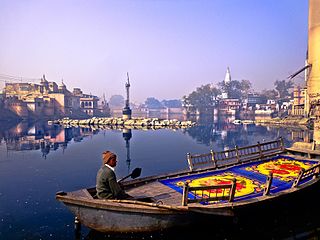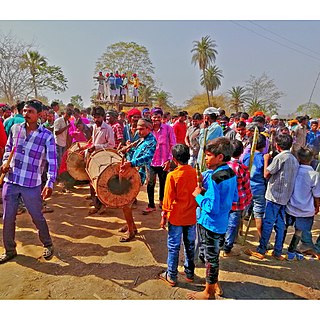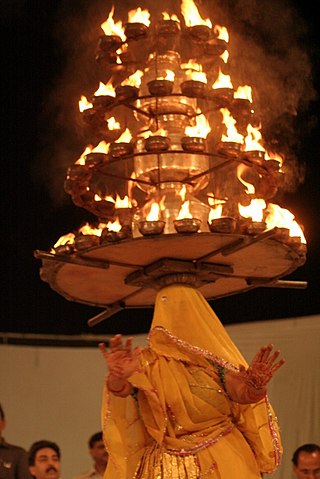Related Research Articles

Madhya Pradesh is a state in central India. Its capital is Bhopal, and the largest city is Indore, with Gwalior, Jabalpur, Ujjain, Dewas, Sagar, Satna, and Rewa being the other major cities. Madhya Pradesh is the second largest Indian state by area and the fifth largest state by population with over 72 million residents. It borders the states of Uttar Pradesh to the northeast, Chhattisgarh to the east, Maharashtra to the south, Gujarat to the west, and Rajasthan to the northwest.

Holi is a popular and significant Hindu festival celebrated as the Festival of Colours, Love and Spring. It celebrates the eternal and divine love of the gods Radha and Krishna. Additionally, the day also signifies the triumph of good over evil, as it commemorates the victory of Vishnu as Narasimha Narayana over Hiranyakashipu. Holi originated and is predominantly celebrated in the Indian subcontinent but has also spread to other regions of Asia and parts of the Western world through the Indian diaspora.

Malwa is a historical region of west-central India occupying a plateau of volcanic origin. Geologically, the Malwa Plateau generally refers to the volcanic upland north of the Vindhya Range. Politically and administratively, it is also synonymous with the former state of Madhya Bharat which was later merged with Madhya Pradesh. At present the historical Malwa region includes districts of western Madhya Pradesh and parts of south-eastern Rajasthan. Sometimes the definition of Malwa is extended to include the Nimar region south of the Vindhyas.

Bhil or Bheel is an ethnic group in western India. They speak the Bhil languages, a subgroup of the Western Zone of the Indo-Aryan languages.

Madhya Pradesh is a state of India. Music from the area includes rural folk and tribal music, ceremonial and ritual music and Indian classical music. Unlike in many parts of India, the people of Madhya Pradesh place few restrictions on who can sing which songs. With the exception of some ritualistic works, people sing songs from across ethnic and racial boundaries.

Mathura district situated along the banks of the river Yamuna is a district of Uttar Pradesh state of north-central India. The historic city of Mathura is the district headquarters. Mathura district is home to many important sites associated with goddess Radha and Krishna, who is believed to be born in Mathura and grew up in the nearby town of Vrindavan. Both cities are some of the most sacred sites in the Vaishnava tradition, making Mathura district an important Hindu pilgrimage centre.

Gangaur is a Hindu festival celebrated in the Indian states of Rajasthan, Haryana, Malwa, Nimaad regions of Madhya Pradesh, Braj and Bundelkhand regions in Uttar Pradesh and Madhya Pradesh. It is also celebrated in some parts of Gujarat and West Bengal. A variation of same festival known as "Chaitra Gauri Vrat" is observed on the same day in the states of Maharashtra & North Karnataka. Another variation called 'Saubhagya Gauri Vratam' is observed in the states of Telangana and Andhra Pradesh.

Vasant Panchami, also rendered Vasanta Panchami and Saraswati Puja in honour of the Hindu goddess Saraswati, is a festival that marks the preparation for the arrival of spring. The festival is celebrated in Indian religions in different ways depending on the region. Vasant Panchami also marks the start of preparation for Holika and Holi, which take place forty days later. The Vasant Utsava (festival) on Panchami is celebrated forty days before spring, because any season's transition period is 40 days, and after that, the season comes into full bloom.

Teej, literally meaning the "third" denoting the third day after the new moon when the monsoon begins as per the Hindu calendar, is a combined name for 3 Hindu festivals primarily dedicated to Hindu deities - the mother goddess Parvati and her male consort Shiva, mainly celebrated by married women & unmarried girls mostly in North India and Nepal to wish for the long life of their husband or future husband and to welcome the arrival of monsoon season with the singing, swings, dancing, enjoyment, prayer rituals and often fast.
Barwaha is a municipality and tehsil in Khargone district in the state of Madhya Pradesh, India. Barwaha is second biggest city of District after Khargone city. The Barwaha city is divided into 18 wards for which elections are held every 5 years. The Barwaha Municipality has population of 39,973 of which 20,940 are males while 19,033 are females as per report released by Census India 2011. Literacy rate of Barwaha is 87.27% higher than state average of 69.32%. In Barwaha, Male literacy is around 92.73% while female literacy rate is 81.23%.
The North Indian state of Himachal Pradesh is a state that has remained largely uninfluenced by Western culture. Himachal Pradesh is a multi-religion practising, multicultural and multilingual state. Some of the most commonly spoken languages are Hindi and the various Pahari languages. The Hindu communities residing in Himachal include the Brahmins, Rajputs, Kannets, Rathis and Kolis. There are also tribal population in the state which mainly comprise Gaddis, Kinnarms, Gujjars, Pangawals and Lahaulis.
Bundeli Utsav (Bundeli Festival) is a cultural festival to promote the Bundeli (Bundelkhandi) folk arts, held in village Basari, tehsil Rajnagar, District Chhatarpur, Madhya Pradesh, India, every year during the spring season for seven days starting from Basant Panchmi. It is organized by Bundeli Vikas Sansthan, an NGO with a mission to performs various social activities and promote Bundeli culture, with the help of Government of Madhya Pradesh’s Department of Culture and Madhya Pradesh State Tourism Development Corporation. Various competitions on folk arts, folk dances, folk songs, food festival, traditional games and archery events are organized during this festival. A large number of participants from eight districts of Madhya Pradesh (Chhatarpur, Datia, Damoh, Katni, Narsinghpur, Panna, Sagar, Shivpuri and Tikamgarh) and five districts of Uttar Pradesh (Banda, Hamirpur, Jalaun, Jhansi and Lalitpur) [Mahoba] take part in these competitions.

The Bhagoria or Bhangoria Festival is celebrated by the tribal people of the Indian states of Madhya Pradesh and Maharashtra. Tribes who participate include the Bhil, Bhilala, and Pateliya.

Charkula is a dance performed in the Braj region of Uttar Pradesh.
Here is a list of glossary of Culture of India in alphabetical order:

Maach is a form of folk theatre from the Malwa region of the Indian state of Madhya Pradesh.
Chang dance is a folk dance from Rajasthan, India. It is also referred to Dhamal, dhuff dance,, and as Holi dance as it is performed during the Hindu festival of the same name (Holi) to celebrate the defeat of evil. It is a group dance performed by men, carousing and singing riotously to the rhythmic beat of the chang instrument.

Chowk-poorana or Chowkpurana is folk art practised in Punjab, Haryana, Himachal Pradesh, Madhya Pradesh and parts of Uttar Pradesh. In Uttar Pradesh, the term chowk-poorana refers to decorating the floor with various designs using flour and rice and also the walls using designs specific to the region.
The National List of Intangible Cultural Heritage (ICH) of India is an attempt to recognize the diversity of Indian culture embedded in its intangible heritage. It aims to raise awareness about the various intangible cultural heritage elements from different states of India at national and international level and ensure their protection.
References
- ↑ "Phulpati Dance in India". india9. 31 July 2014.
- 1 2 "PHULPATI DANCE- MADHYA PRADESH".
- 1 2 "Phulpati Dance of Madhya Pradesh".